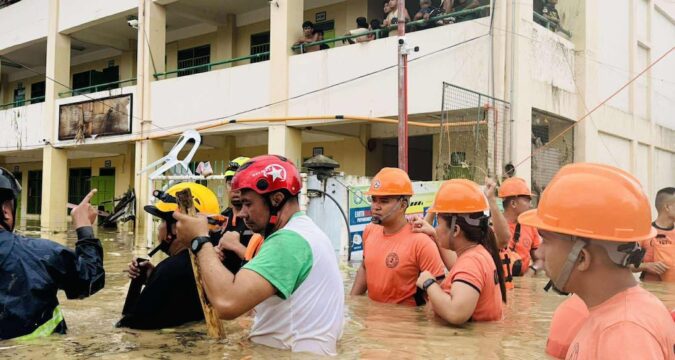
MANILA (UCAN/SE): As Typhoon Kalmaegi [Tino] made landfall in the central Philippines on November 4, the country’s PAGASA weather agency warned of “life threatening” conditions in large parts of the Visayas region. With the storm packing gale-force winds of between 130 kph to 180 kph along with heavy rains and the threat of flooding, the Department of the Interior and Local Government called for the evacuation—preemptive and mandatory—of high risk areas.
At least 250,000 people have been evacuated to six shelters across the Eastern Visayas region alone,, according to the Office of Civil Defense. Media reports as of November 6 reported over 140 deaths and another 127 missing.
In Cebu, Archbishop Alberto Uy directed all priests to open churches in the archdiocese as shelters for those seeking refuge during the storm, except for those damaged in a recent earthquake.
“People marooned on rooftops are asking to be rescued,” Cebu information officer Rhon Ramos said, adding that even some evacuation centres had been flooded.
“The water rose so fast,” said 28-year-old Don del Rosario, who was among those in Cebu City who took refuge on an upper floor. He added, “From what I’ve been told, the flooding started around 3:00am. By 4:00am, it was already uncontrollable—people couldn’t get out [of their houses].”
In Cebu, Archbishop Alberto Uy directed all priests to open churches in the archdiocese as shelters for those seeking refuge during the storm, except for those damaged in a recent earthquake
Del Rosario said, “I’ve been here for 28 years, and this is by far the worst we’ve experienced.”
Hundreds still living in tent cities following the 6.9-magnitude quake that rocked the island in late September were also “forcibly evacuated for their own safety,” Ramos said.
Monsignor Oscar Cadayona, vicar general of the Diocese of Maasin, urged people not to lose hope and called on others to help affected communities.
“As one disaster comes after another, it may destroy the structures we have built on earth, but no hardships, difficulties and discomforts we have gone through can destroy our faith and trust in God, the creator of this world,” he said.
As we celebrate the 500 years of Christianity in the Philippines. The Chaplaincy to Filipino Migrants organises an on-line talk every Tuesday at 9.00pm. You can join us at:
https://www.Facebook.com/CFM-Gifted-to-give-101039001847033
The Philippines is hit by an average of 20 storms and typhoons each year, routinely striking disaster-prone areas where millions live in poverty. Typhoon Kalmaegi is the 20th this year PAGASA specialist, Charmagne Varilla, said on November 3, adding at least “three to five more” storms could be expected by December’s end.
Scientists warn that storms are becoming more frequent and more powerful due to human-driven climate change.
As one disaster comes after another, it may destroy the structures we have built on earth, but no hardships, difficulties and discomforts we have gone through can destroy our faith and trust in God, the creator of this world
Monsignor Oscar Cadayona
Varilla said that higher numbers of cyclones typically accompany La Niña, a naturally occurring climate pattern that cools surface temperatures in the central and eastern equatorial Pacific Ocean.
In Dinagat Islands province, where Kalmaegi first made landfall, 34-year-old Miriam Vargas sat with her children in the dark on the night of November 3, praying as the winds slammed against the walls of her home.
“There is strong rain and winds starting. We’re sitting on the stairs and praying while trying to gauge the typhoon’s strength,” the single mother said.
“The wind is whistling and there are sounds of things falling. The electricity went out about an hour ago, and we cannot see anything.”
On nearby Leyte, disaster official Roel Montesa said evacuations were “ongoing in Palo and Tanauan” naming two of the towns hardest hit by storm surges in 2013, when Super Typhoon Haiyan killed more than 6,000 people there.
In a televised speech on November 4, the president, Ferdinand Marcos Jr., said that government agencies had been directed to hasten relief and recovery operations in affected regions.
The Philippines was hit by two major storms in September, including Super Typhoon Ragasa [Nando], which toppled trees and tore the roofs off buildings on its way to killing 14 people in nearby Taiwan.



